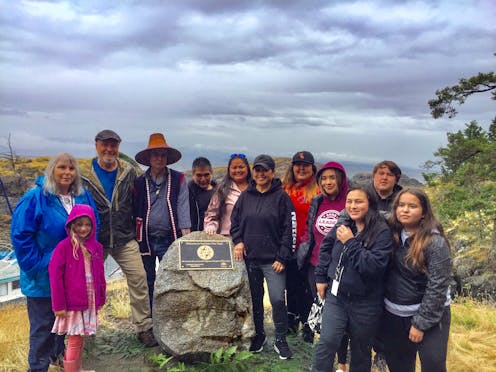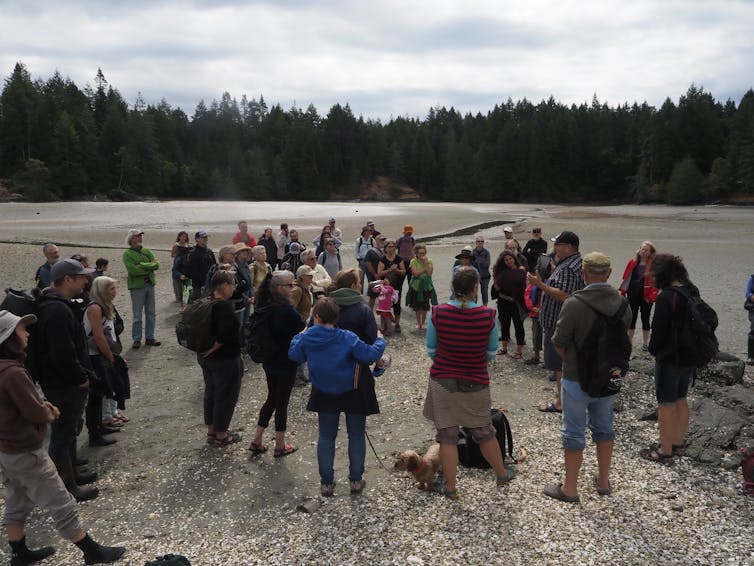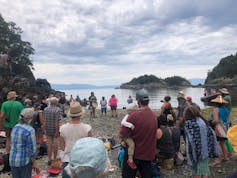
We are standing in a circle on an expansive beach in front of an ancient rock-walled fish-trap — one of many archaeological sites on the small island of Xwe’etay (Lasqueti) in the Salish Sea between Vancouver Island and the British Columbian mainland.
We are joined by about 80 island locals who clambered over slippery rocks to hear about the archaeological heritage of the island and to meet members of the Tla’amin Nation, who have historical ancestral interests on Xwe’etay.
This is the first time any of the islanders have met their northern Coast Salish neighbours and the first time these Tla’amin community members have visited these ancestral lands.
Together we sound out the ancestral name of the island: “wha-et-tai” — the northern Coast Salish term for yew tree. It doesn’t matter that most of us said it wrong. What matters is the saying of it — and in doing so, acknowledging another people’s history and place on the island.
This one collective gesture illustrates the power of community-engaged archaeology to build bridges, contribute to scientific understanding, and advance the process of reconciliation.

Our work on the Xwe’etay/Lasqueti Archaeology Project (XLAP) is founded on the belief that archaeology can be a powerful catalyst for cross-community conversations about deep Indigenous connections to their lands and seas. These connections include the less visible teachings which shape the cultural practices that celebrate these connections.
Archaeology on Xwe’etay
Many archaeologists understand that practicing archaeology comes with a responsibility to descendant communities whose history, cultural identity, and health are embedded in the archaeological record. This recognition often arises from Indigenous People’s desire to take charge of managing the stewardship of their traditional territories. It has motivated many archaeologists to create meaningful partnerships with Indigenous communities.
Far less common, however, is for archaeologists to deeply engage with settler communities whose past may not be reflected in the archaeological record. These communities, nonetheless, feel either a connection to the land, hold private property rights associated with sites, or feel connected to the archaeological record in scientific or personal ways.
Modern Lasqueti Island is a microcosm of the Indigenous heritage found elsewhere in British Columbia and beyond. Indigenous history is evident in a rich and varied archaeological record. Over the last eight or more decades, this record has slowly and continuously been eroded by small-scale development. At the same time, the settler island community of Lasqueti has developed their own connections to the land on which they live, and the community of which they are a part.
No Indigenous descendants of the land have lived on the island for two centuries because of a myriad of intentional colonial impacts. Today, at least 13 Northern Coast Salish, Coast Salish, and Kwakwakaʼwakw Nations claim varying interests in the island’s land and sea.

Eroding Canadian myths
There are at least two ways that the XLAP team engages actively with the vast potential of archaeology to bring communities together. First are the many on-going discussions with island landowners and other residents about Indigenous heritage. These discussions involve sharing information about our archaeological findings and talking about the ethical and legal responsibilities of landowners regarding archaeological sites on their property.
Second, our island-wide exploration of archaeological heritage has provided chances for the island’s current inhabitants and the project’s Indigenous partners to get their hands dirty screening and excavating. Touching the past in this way is a powerful way for people to see the land differently and to rethink their responsibility towards it.
Through our engaged archaeological work, we are slowly eroding the Canadian myth that has facilitated the destruction of Indigenous heritage and other intentional policies of cultural genocide. As one settler resident of the island said:
“…sifting through the layers of time and lives. What an opening of my eyes to the extent of Native settlement on Lasqueti — and the whole coast. I could almost hear the clatter of the Victorian-patterned curtains on my eyes fall away to learn that the "middens,” which the colonial narrative has regarded as the rubbish heaps, are actually carefully built house floors of excellent drainage materials. There goes another myth of the wild B.C. coast.“
Myths such as these have served to shield settlers from the reality that Indigenous connection to the land goes back hundreds of generations, rooted in flood and creation stories. So far, our oldest radiocarbon dated archaeological site on Xwe’etay is 3,800 years old.

Bringing communities together
Community-engaged archaeology offers a visceral jolt to the process of reconciliation. You can’t unsee a landscape with terraced slopes that were shaped over generations by Indigenous settlements and on which today’s settlers have built their homes. You can’t unsee the fish traps and clam gardens that reflect the extensive engineering and management of the intertidal zone. And, you can’t unsee the archaeological sites lining the shoreline that are composed of layers of shells and evidence of past lives lived.
Accepting these truths about Indigenous connections to the land provides a foundation to begin healing past wrongs and for creating bridges. As said by Kim Recalma-Clutesi, whose brother, Mark Recalma is the hereditary chief of the Pentlatch (Qualicum) Nation territory that includes Xwe’etay:
"You know, we’ve been fighting for a long time. And we’ve been advocates for a long time… It’s time for us to hear your kind words and your gestures. To hear it and embrace it. But it’s also time for you to put the guilt down. Because they’re both debilitating… And our path forward is working together. We don’t give you permission to [feel guilt]. We give you permission to move forward and do more of what you’ve done.”

Project advisor and archaeologist Christine Roberts from Wei Wai Kum Nation adds, “I think this is a really unique situation you guys have here and I think it’s really cool because all of the archaeology that you’re finding adds to the story — which becomes your story.”
We have witnessed the social transformations that are brought about through people’s interest and curiosity about the past. The archaeology of Xwe’etay is extensive and remarkable. Recording and recognizing it as we are doing in XLAP provides a chance to honor the deep Indigenous history it represents.
For Indigenous communities, community-engaged archaeology facilitates connecting with their ancestral practices and places. For settlers, it can be a way to imagine the diversity and richness of past lives in the places that they now call home.
Recognizing the richness of that history can evoke a variety of emotions. These include fear for some, but also humility and awe, as well as a deepening of their own connections to those places. It is through many small conversations and mutual respect for past and present inhabitants of these lands that reconciliation may begin.
Dana Lepofsky receives funding from SSHRC
Sean Markey receives funding from SSHRC.
Christine Roberts and Oqwilowgwa Kim Recalma-Clutesi do not work for, consult, own shares in or receive funding from any company or organisation that would benefit from this article, and have disclosed no relevant affiliations beyond their academic appointment.
This article was originally published on The Conversation. Read the original article.







